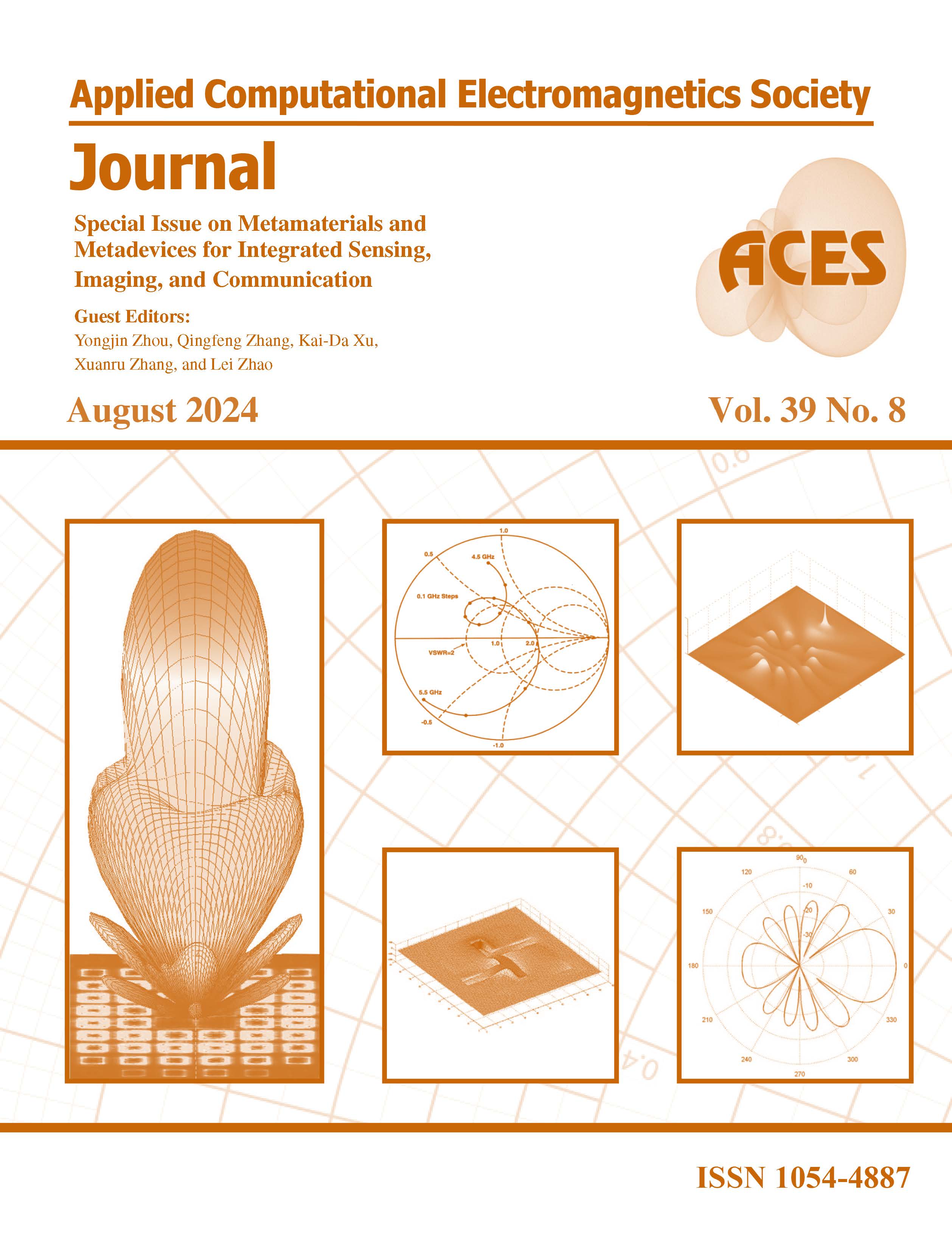Optimization of Multilayer Microwave Absorbers using Multi-strategy Improved Gold Rush Optimizer
DOI:
https://doi.org/10.13052/2024.ACES.J.390806Keywords:
Absorbing material, gold rush optimizer, multilayer microwave absorber, reflection coefficientAbstract
In this study, a multi-strategy improved gold rush optimizer (MIGRO) is proposed for the design of multilayer broadband microwave absorbers (for normal incidence). The purpose of this optimization process is to minimize the maximum reflection coefficient of the absorber by selecting appropriate material layers from existing literature databases within the desired frequency range. To enhance the performance of a gold rush optimizer (GRO), three improvement strategies are proposed. This paper demonstrates the effectiveness of the improved strategy and the superior reflection coefficient of the MIGRO compared to other heuristic algorithms used for the design of microwave absorbers through two different simulation examples.
Downloads
References
R. Panwar, S. Puthucheri, D. Singh, and V Agarwala, “Design of ferrite-graphene-based thin broadband radar wave absorber for stealth application,” IEEE Transactions on Magnetics, vol. 51, no. 11, pp. 1-4, Nov. 2015.
A. Delfini, M. Albano, A. Vricella, F. Santoni, G. Rubini, R. Pastore, and M. Marchetti, “Advanced radar absorbing ceramic-based materials for multifunctional applications in space environment,” Materials, vol. 11, no. 9, p. 1730, Sep. 2018.
S. Xie, Z. Ji, L. Zhu, J. Zhang, Y. Cao, J. Chen, R. Liu, and J. Wang, “Recent progress in electromagnetic wave absorption building materials,” Journal of Building Engineering, vol. 27, p. 100963, Jan. 2022.
S. Ren, H. Yu, L. Wang, Z. Huang, T. Lin, Y. Huang, J. Yang, Y. Hong, and J. Liu, “State of the art and prospects in metal-organic framework-derived microwave absorption materials,” Nano-Micro Letters, vol. 14, no. 1, p. 68, Feb.2022.
H. Pang, Y. Duan, L. Huang, L. Song, J. Liu, T. Zhang, X. Yang, J Liu, X. Ma, J Di, and X. Liu, “Research advances in composition, structure and mechanisms of microwave absorbing materials,” Composites Part B: Engineering, vol. 224, p. 109173, Nov. 2021.
R. Panwar and J. R. Lee, “Recent advances in thin and broadband layered microwave absorbing and shielding structures for commercial and defense applications,” Functional Composites and Structures, vol. 1, no. 3, p. 032022, July 2019.
E. Michielssen, J. M. Sajer, S. Ranjithan, and R. Mittra, “Design of lightweight, broad-band microwave absorbers using genetic algorithms,” IEEE Transactions on Microwave Theory and Techniques, vol. 41, no. 6, pp. 1024-1032, June/July 1993.
S. Chamaani, S. A. Mirtaheri, and M. A. Shooredeli, “Design of very thin wide band absorbers using modified local best particle swarm optimization,” AEU-International Journal of Electronics and Communications, vol. 62, no. 7, pp. 549-556, Aug. 2008.
S. Roy, S. D. Roy, J. Tewary, A. Mahanti, and G. Mahanti, “Particle swarm optimization for optimal design of broadband multilayer microwave absorber for wide angle of incidence,” Progress in Electromagnetics Research B, vol. 62, pp. 121-135, Feb. 2015.
S. K. Goudos, “Design of microwave broadband absorbers using a self-adaptive differential evolution algorithm,” International Journal of RF and Microwave Computer-Aided Engineering, vol. 19, no. 3, pp. 364-372, Apr. 2009.
N. I. Dib, M. Asi, and A. Sabbah, “On the optimal design of multilayer microwave absorbers,” Progress in Electromagnetics Research C, vol. 13, pp. 171-185, 2010.
M. Asi and N. I. Dib, “Design of multilayer microwave broadband absorbers using central force optimization,” Progress in Electromagnetics Research B, vol. 26, pp. 101-113, 2010.
Y. Lu and Y. Zhou, “Design of multilayer microwave absorbers using hybrid binary lightning search algorithm and simulated annealing,” Progress in Electromagnetics Research B, vol. 78, pp. 75-90, 2017.
S. Kankı
lı
ç and E. Karpat, “Optimization of multilayer absorbers using the bald eagle optimization algorithm,” Applied Sciences, vol. 13, no. 18, p. 10301, Sep. 2023.
S. Roy, A. Mahanti, S. D. Roy and G. K. Mahanti, “Comparison of evolutionary algorithms for optimal design of broadband multilayer microwave absorber for normal and oblique incidence,” Applied Computational Electromagnetics Society (ACES) Journal, vol. 31, no. 1, pp. 79-84, Jan. 2016.
T. Wang, G. Chen, J. H. Zhu, H. Gong, L. M. Zhang, and H. J. Wu, “Deep understanding of impedance matching and quarter wavelength theory in electromagnetic wave absorption,” Journal of Colloid and Interface Science, vol. 595, pp. 1-5, Aug. 2021.
K. Zolf, “Gold rush optimizer: A new population-based metaheuristic algorithm,” Operations Research and Decisions, vol. 33, no. 1, pp. 113-150, 2023.
M. Saglam, Y. Bektas, and O. A. Karaman, “Dandelion optimizer and gold rush optimizer algorithm-based optimization of multilevel inverters,” Arabian Journal for Science and Engineering, vol. 49, pp. 7029-7052, Jan. 2024.
H. Abdelfattah, M Esmail, S. A. kotb, M. M. Mahmoud, H. S. Hussein, D. E. M. Wapet, A. I. Omar, and A. M. Ewais, “Optimal controller design for reactor core power stabilization in a pressurized water reactor: Applications of gold rush algorithm,” Plos One, vol. 19, no. 1, p. e0287772, Jan.2024.
Z. Wang, L. Huang, S. Yang, D. Li, D. He, and S. Chan, “A quasi-oppositional learning of updating quantum state and Q-learning based on the dung beetle algorithm for global optimization,” Alexandria Engineering Journal, vol. 81, pp. 468-488, Oct. 2023.
W. Liu, Z. Wang, Y. Yuan, N. Zeng, K. Hone, and X. Liu, “A novel sigmoid-function-based adaptive weighted particle swarm optimizer,” IEEE Transactions on Cybernetics, vol. 51, no. 2, pp. 1085-1093, July 2019.
Q. Liu, N. Li, H. Jia, Q. Qi, L. Abualigah, and Y. Liu, “A hybrid arithmetic optimization and golden sine algorithm for solving industrial engineering design problems,” Mathematics, vol. 10, no. 9, p. 1567, May 2022.
E. Yigit and H. Duysak, “Determination of optimal layer sequence and thickness for broadband multilayer absorber design using double-stage artificial bee colony algorithm,” IEEE Transactions on Microwave Theory and Techniques, vol. 67, no. 8, pp. 3306-3317, Aug. 2019.
H. Yao, J. Yang, H. Li, J. Xu, and K. Bi, “Optimal design of multilayer radar absorbing materials: A simulation-optimization approach,” Advanced Composites and Hybrid Materials, vol. 6, no. 1, p. 43, Jan. 2023.
P. Warhekar, A. Bhattacharya, and S. Neogi, “Designing thinner broadband multilayer radar absorbing material through novel formulation of cost function,” IEEE Access, vol. 11, pp. 91016-91027, Oct. 2023.




